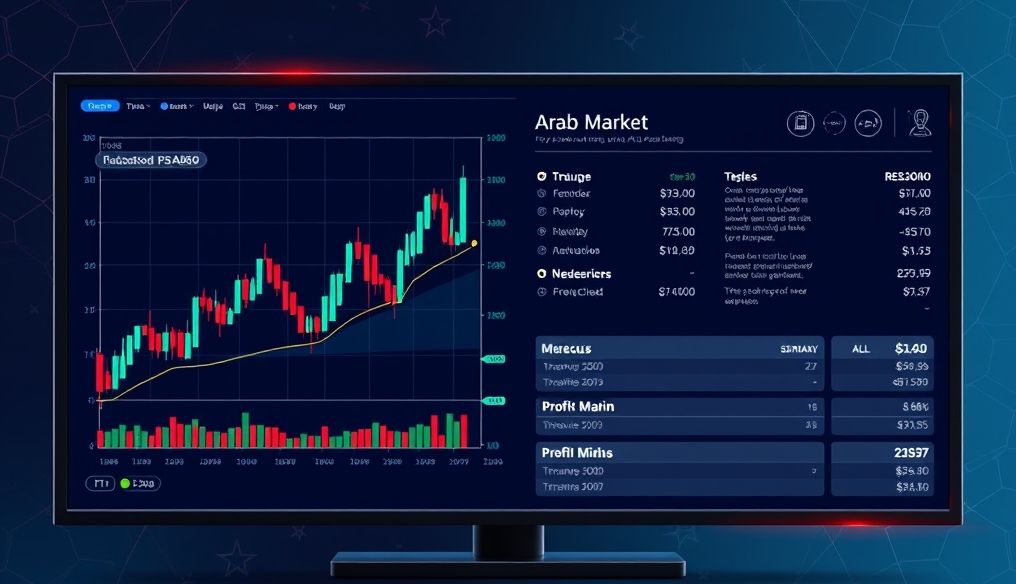Introduction: Technical and Fundamental Analysis - An Overview
In the world of investing, two main approaches compete for analyzing markets and making decisions: technical analysis and fundamental analysis. Both seek to achieve the same goal - identifying profitable investment opportunities - but they rely on completely different tools and methods. In Arab markets, which are characterized by unique volatility and specific challenges, understanding the strengths and weaknesses of each of these approaches becomes crucial.
Chapter 1: Fundamental Analysis - Diving Deep into Companies
Fundamental analysis is an approach that focuses on evaluating the intrinsic value of an asset, whether it's a stock, bond, or currency. It relies on studying the financial data of a company or the macroeconomics of a country to determine whether the asset is undervalued or overvalued.
1.1. Elements of Fundamental Analysis
- Financial Statements: Analyzing the balance sheet, income statement, and cash flow statement to assess the company's profitability, debt, and operational efficiency.
- Industry: Understanding the dynamics of the industry in which the company operates, including competition, potential growth, and regulatory challenges.
- Macroeconomics: Analyzing economic indicators such as GDP, inflation rates, and interest rates to assess the overall economic environment that affects the company's performance.
- Management: Evaluating the quality of management and its ability to make sound strategic decisions and achieve the company's goals.
1.2. Practical Example: Analyzing Saudi Aramco
When analyzing a company like Saudi Aramco, a fundamental analyst looks at oil production data, global oil prices, production costs, taxes, and dividend distributions. They also consider geopolitical factors that may affect oil production and prices. Based on these factors, the analyst can estimate the intrinsic value of Aramco's stock and compare it to the current market price to determine whether the stock is undervalued or overvalued.
Chapter 2: Technical Analysis - Reading the Language of Charts
Technical analysis is an approach that relies on studying price charts and trading volumes to identify patterns and trends that may indicate future price movements. Technical analysis assumes that all relevant information is already contained in the asset's price and that history repeats itself.
2.1. Tools of Technical Analysis
- Charts: Using different types of charts such as line charts, bar charts, and candlestick charts to display price movements over time.
- Technical Indicators: Using mathematical indicators such as moving averages, the Relative Strength Index (RSI), and the Moving Average Convergence Divergence (MACD) to identify overbought and oversold conditions and confirm trends.
- Chart Patterns: Recognizing common chart patterns such as head and shoulders, double tops and bottoms, and triangles to predict trend reversals or continuations.
- Support and Resistance Levels: Identifying price levels that tend to act as barriers to price movement, where the price finds it difficult to break above the resistance level or fall below the support level.
2.2. Practical Example: Analyzing Al Rajhi Bank Stock
Using technical analysis for Al Rajhi Bank's stock, an analyst might notice a "head and shoulders" pattern on the chart, indicating a potential reversal of the uptrend. They might also use the RSI to determine if the stock is in the overbought zone, which could indicate a potential price correction. Based on these technical signals, the analyst can decide to sell the stock or reduce the size of their position.
Chapter 3: Strengths and Weaknesses of Fundamental Analysis
Both fundamental analysis and technical analysis have strengths and weaknesses that investors should be aware of.
3.1. Strengths of Fundamental Analysis
- Focus on Intrinsic Value: Helps investors identify undervalued assets, which can lead to rewarding long-term returns.
- Deep Understanding of Business: Provides a comprehensive understanding of the company's business and the factors that affect its performance.
- Long-Term Investment: Suitable for investors looking for long-term investments built on strong foundations.
3.2. Weaknesses of Fundamental Analysis
- Time-Consuming: Requires collecting and analyzing large amounts of data, which can be time-consuming and effort-intensive.
- Difficulty Predicting Short-Term Prices: May not be effective in predicting short-term price movements due to other factors such as market sentiment and unexpected news.
- Reliance on Assumptions: Relies on assumptions about future growth and financial performance, which may be inaccurate.
Chapter 4: Strengths and Weaknesses of Technical Analysis
4.1. Strengths of Technical Analysis
- Speed and Efficiency: Can be applied quickly and easily to a wide range of assets.
- Predicting Short-Term Prices: Effective in predicting short-term price movements, making it suitable for day traders and swing traders.
- Identifying Entry and Exit Points: Helps identify potential entry and exit points in trades.
4.2. Weaknesses of Technical Analysis
- Reliance on History: Assumes that history repeats itself, which may not always be true.
- False Signals: May produce false signals, leading to losses.
- Ignoring Fundamental Factors: Does not take into account fundamental factors that may affect the value of the asset.
Chapter 5: Specific Challenges in Arab Markets
Arab markets are characterized by unique characteristics that make applying technical and fundamental analysis more complex.
5.1. Limited Data:
Available financial and economic data may be less comprehensive and reliable compared to developed markets.
5.2. Low Liquidity:
Liquidity may be low in some Arab markets, which can lead to sharp price fluctuations and difficulty in executing trades.
5.3. Political Influence:
Arab markets are significantly affected by political and geopolitical events, which can lead to unexpected price fluctuations.
5.4. Investment Culture:
The investment culture in some Arab markets may be less developed, which can lead to irrational investment decisions.
Chapter 6: Combining Technical and Fundamental Analysis - The Optimal Approach
Instead of relying on just one approach, investors can achieve the best results by combining technical and fundamental analysis.
6.1. Using Fundamental Analysis to Identify Promising Assets:
Fundamental analysis can be used to identify companies or sectors with strong foundations and good growth potential.
6.2. Using Technical Analysis to Identify Entry and Exit Points:
Technical analysis can be used to identify ideal entry and exit points in trades based on price action and trends.
6.3. Risk Management:
Investors should always manage risk by setting position sizes and using stop-loss orders.
Chapter 7: Practical Examples of Combining Technical and Fundamental Analysis in Arab Markets
Let's look at some practical examples of how to combine technical and fundamental analysis in Arab markets.
7.1. Investing in the Saudi Banking Sector:
A fundamental analyst may analyze the financial data of Saudi banks to identify banks with strong balance sheets and high profitability ratios. Then, they use technical analysis to identify ideal entry points in the stocks of these banks based on charts and technical indicators.
7.2. Trading in the Oil Market:
A fundamental analyst may follow news about global oil production, inventories, and geopolitical factors affecting oil prices. Then, they use technical analysis to identify short-term trends in oil prices and make trading decisions based on these trends.
Chapter 8: Tips for Investors in Arab Markets
Here are some tips for investors in Arab markets:
- Continuous Education: Continue to learn more about technical and fundamental analysis and understand Arab markets.
- Diversification: Diversify your investment portfolio to reduce risk.
- Patience: Be patient and do not expect to make quick profits.
- Professional Advice: Consult a qualified financial advisor before making any investment decisions.
Chapter 9: Tools and Information Sources for Arab Investors
There are many tools and information sources available to Arab investors:
- Financial News Websites: Such as Argaam, Bloomberg الشرق, and Reuters.
- Trading Platforms: That provide technical analysis tools and charts.
- Research Firms: That provide analytical reports on companies and sectors.
- Seminars and Training Courses: That teach you the basics of technical and fundamental analysis.
Chapter 10: Conclusion and Recommendations
In conclusion, both technical and fundamental analysis are valuable tools for investors in Arab markets. However, the optimal approach is to combine both approaches to gain a comprehensive view of the market and make informed investment decisions. Investors should also be aware of the specific challenges of Arab markets and follow a disciplined investment strategy.



